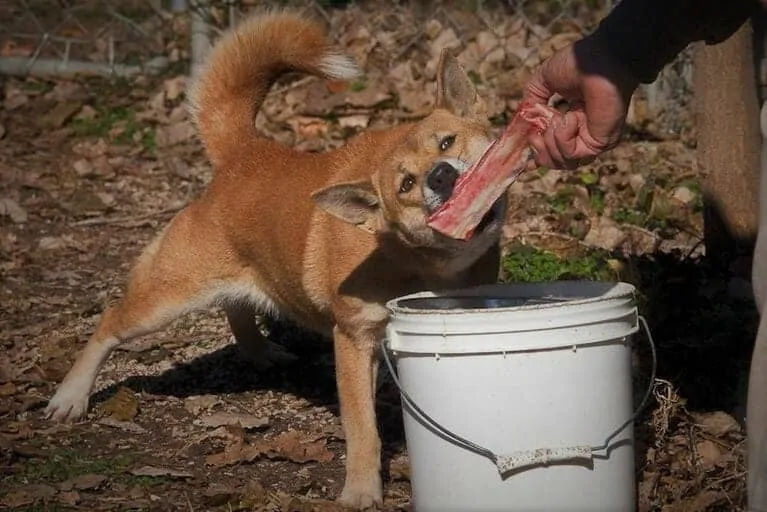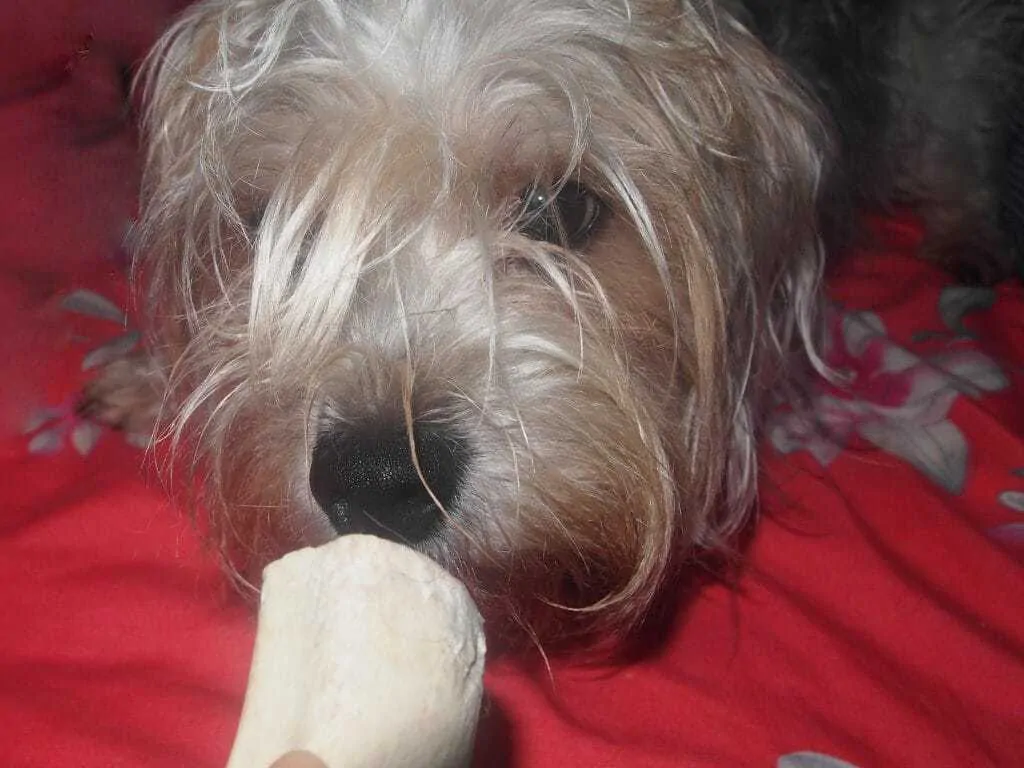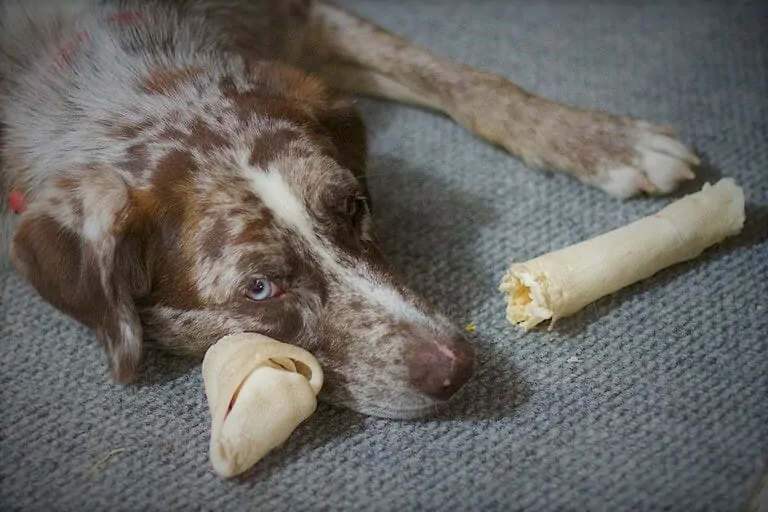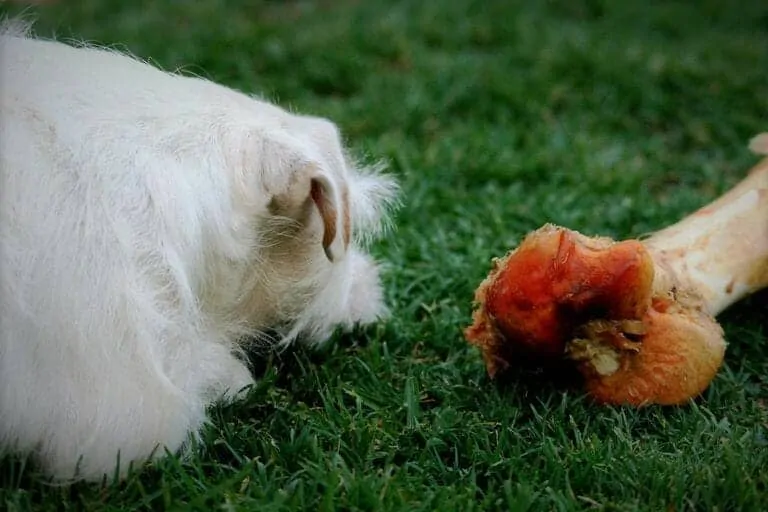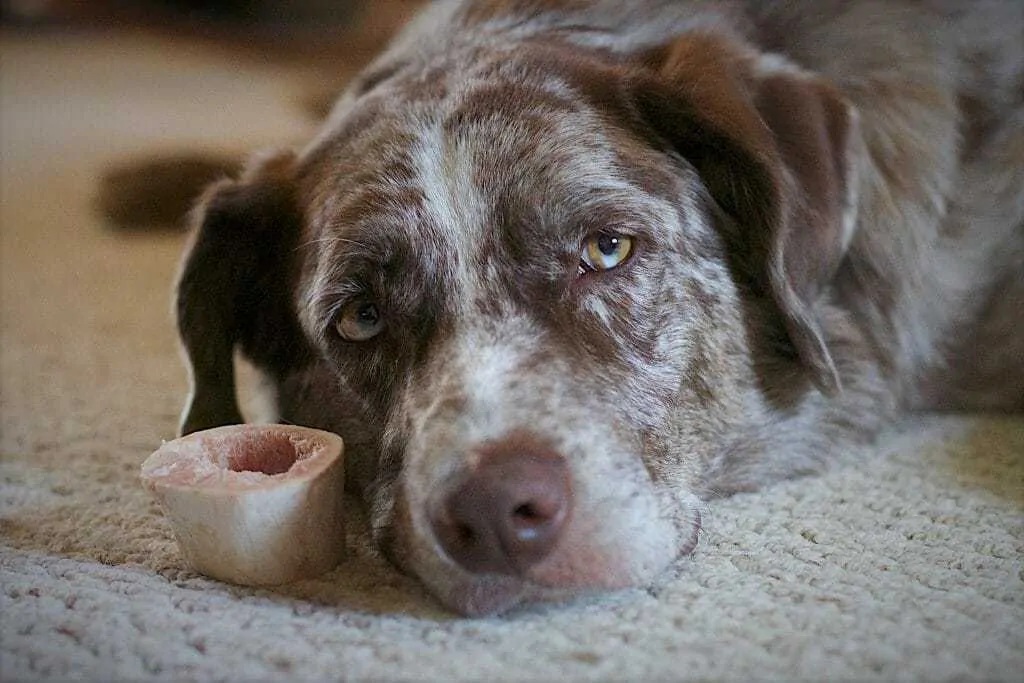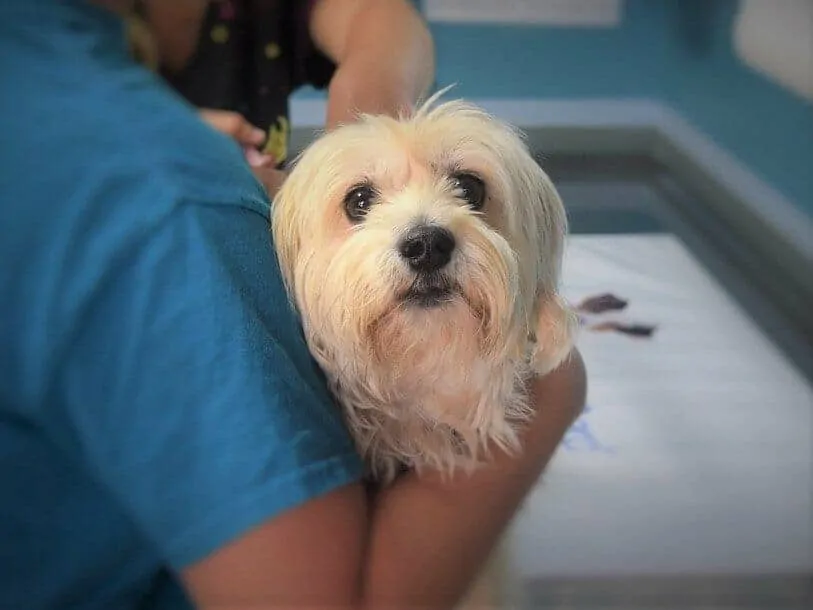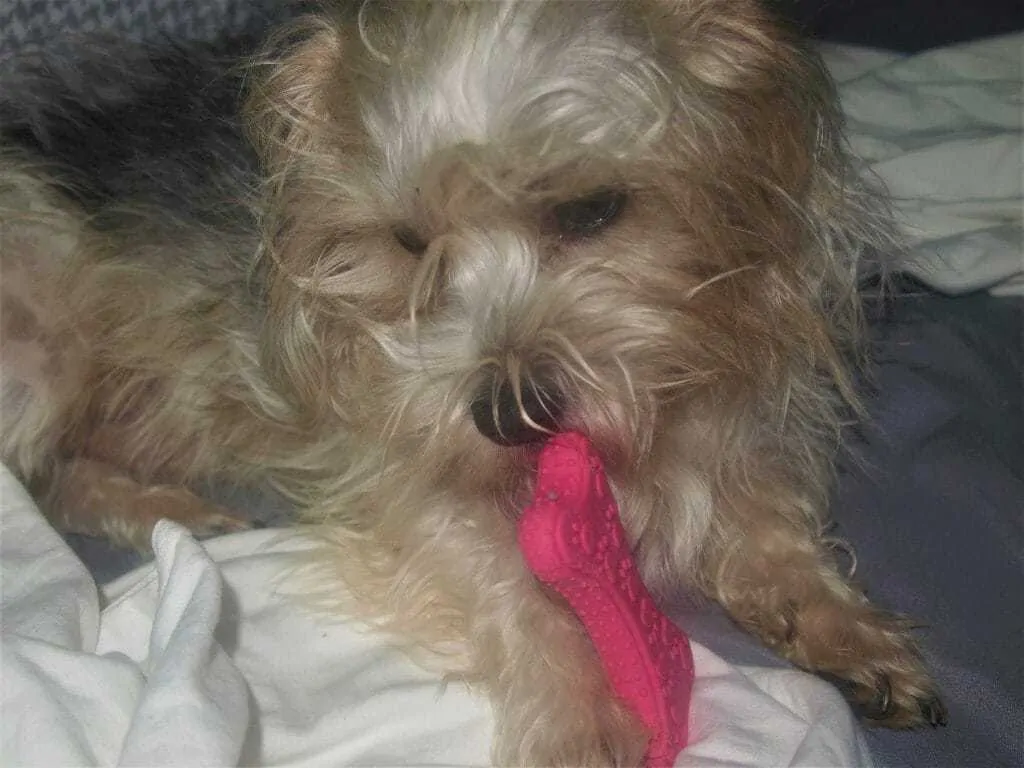It’s very tempting to give in and toss your dog a bone, and why would you not? They beg for it so pitifully and you’d only be throwing it out in the end anyway. However, have you ever actually considered what kind of bones are safe for dogs?
There is, fortunately, somewhat of a consensus on this topic.
According to all the major dog health sources, for example, raw bones are always better than cooked bones. It’s also recommended that you go for larger bones. And, lastly, if your dog has a history of stomach conditions, it’s best to keep them away from bones completely.
This, however, is more of a general guideline. If you want to learn more about what kind of bones are actually safe for dogs? Continue reading.
Contents
Raw Bones vs Cooked Bones?
A small dog being handed a large raw bone! Is this considered safe for your dog? It’s straight from the source, no deboning, and slightly larger than the dog’s head. BUT, surprisingly enough, it is actually safe enough that this little guy should be able to chew through it without any problems!
One of the rules we introduced in the very beginning is that you should always opt for raw bones over cooked bones. However, as far as what is actually considered safe? The details are a little hazier than I’m sure you’d like.
Most would recommend raw bones over cooked bones any day. However, according to PetMD, even raw bones can result in major complications.
You see, the risk-factor will heighten or decrease depending on the type or even the size of the bone. For example, a large raw bone of lamb (approximately the size of your dog’s head) is safer than brittle cooked beef bone.
That much, should be pretty obvious. However, on the opposite side of the fence, a raw turkey or chicken bone is more dangerous than a large cooked beef bone. So, it really is all in the details.
Raw Bones? Are They Nutritionally Beneficial?
What’s on the Raw Diet Menu? I looked this up myself a couple of years ago, and according to some sources… It’s a good helping of raw meat (bone-in), a calcium-source (mostly contrived out of crushed eggshells), healthy fats, grains, and other nutritious ingredients.
These days, many dog owners are proud to take up what they call the “raw diet,”, in praise of the nutritional benefits that raw meat is supposedly able to provide. In their eyes, this home-prepared meal is better than all the alternative dog foods available in the market.
Now, in this, they aren’t completely wrong. You see, raw meat is nutritious.
However, it is also a bit of a dangerous game. See, while raw bones can provide calcium, phosphorus, and other minerals, the main source of nutrients is actually the meat itself. So, in all actuality, the bone? Isn’t really necessary in this equation.
Can Bones Strengthen Dog Teeth?
Cass (Shih-Tzu breed) opens his mouth wide for a shot! His gums and teeth are in peak condition! It’s important to take the time to inspect your dog’s teeth whenever possible.
One of the reasons people promote raw bones over cooked bones is its studied benefits on teeth and overall dental care. These studies have found that raw bones can actually promote better dental health in dogs.
Specifically, raw bones are praised as a great method of reducing plaque-build up or preventing gum disease. For this, the study recommended that you feed your dog a healthy helping of raw beef bones every day for 12-20 days. With the studies that were done in a shorter period of time seeing more success than those conducted over the longer-end of the spectrum.
I found that doing this did actually help my dog, Misha. The poor girl had been suffering from dental issues for a while, so I decided to give it a shot! She’s on the smaller side – less than 15lbs in weight, so I made sure to buy raw beef bones that were proportional to her size.
I only kept this up for a week or so. BUT, to my surprise, it did help! It got rid of the rest of her baby teeth very quickly and strengthened her gums to promote the growth of a new and stronger set of biters.
Beef Bones
Jensen (Maltese-mixed dog) being offered a cooked beef bone. He knows to wait until I say go before taking it from my hands, and I watch him very closely while he chews in order to prevent any unhappy accidents.
I’m guilty of having given my dogs cooked beef bones. However, I do try my best to choose bones that are less likely to splinter and break apart by picking the bigger bones of the batch. I’ve also trained my dogs to let go when ordered and observe them closely so that I know when to take it away.
Confession aside, are beef bones actually safe for dogs? Well… again, the details are a little hazier than any of us would probably like, but I’ll be breaking it down as best as I can.
Raw Beef Bones
The general consensus does seem to approve of raw beef bones. As mentioned earlier, these are great for promoting good dental health and are highly nutritious to boot. They’re also less likely to splinter when raw, and are far easier to chew.
The only thing that you need to consider is the size of your dog and the size bone. In this case, it’s recommended that you pick a bone that is proportional to your dog’s head.
Cooked Beef Bones
This subject is a bit more controversial. However, as I spouted off in my little confession earlier, my dogs do just fine chewing on cooked beef bones. Of course, these are riskier. However, as long as you choose bones that are very large and thick, you should be fine.
Just make sure you toss away any bones that appear brittle or narrow, as these have a tendency of shattering into pieces and piercing your dog’s insides.
As a general tip, you should also make sure that you keep an eye on your dog whenever they’re given cooked beef bones. You’ll also want the ability to be able to take it away (without being bitten), so training your dog the ‘let go’ or ‘drop it’ command will be very helpful in this case.
Chicken/Turkey Bones
Chicken bones break and splinter easily, much too easily for comfort, in fact. So, make sure that your dog stays safe by keeping it away – raw OR cooked!
According to the FDA (the Food and Drug Administration), chicken bones are a BIG NO. Just no. It’s not something that you should give your dog, ever.
That doesn’t mean that the nutritious benefits of raw meat that we hyped earlier were lies. Because raw chicken meat can be healthy and nutritious. However, something being nutritious and ‘natural,’ doesn’t necessarily equate it to being safe.
Chicken bones pose a big choking hazard when eaten raw and are much too brittle and sharp to be eaten when cooked.
If you want to keep your dog from choking or having their gastrointestinal tract punctured, then this is something that you need to keep them away from. I’ve had many of these accidental scares before when I was younger, and there is nothing more terrifying than having to get your dog treated for something like this – especially when you know that it could immediately result in death.
So, my advice? Train your dogs the command for ‘eat’ and ‘let go’ and stay on top of your game so that your best friend won’t sneakily steal the fried chicken that you left on the table. Trust me, it happens a lot more often than you’d think.
Pork Bones
While most of us would probably enjoy chewing on a well-cooked pork-bone, it is better that these bones are kept far away from our dogs.
Pork bones, especially in rib form, are just as bad as chicken bones.
These are very likely to splinter and are big choking hazards. So, again, just like we recommended with the chicken bones, keep these away from your dogs. This is true whether the pork bone is raw or cooked.
In most cases, eating one of these might necessitate a visit to the vet. Especially if your dog is expressing symptoms of an upset gastrointestinal tract (which include vomiting, diarrhea, or a sudden loss of appetite.)
Lamb Bones
As for lamb bones, these are on the same boat as beef bones.
They’re better when served raw but giving your dog cooked lamb bone won’t hurt them, as long as you pick one that is relatively large and thick. Of course, if you want to throw your dog a lamb bone, it’s important that you watch them carefully while they chew. Because there will come a point where it will be necessary that you take it away.
As an extra side note, lamb bones just so happen to be a great source of magnesium. This is something that a lot of dog owners tend to struggle to provide for their dogs. So, if you ever find yourself with a cooked lamb bone that is just a little bit too small?
You might want to consider grinding it up and mixing it into your dog’s regular food bowl. Doing this could even potentially improve your dog’s mood!
What You Should Do When Your Dog Eats A Bad Bone
It’s impossible to watch your dog at all times, and no amount of training is going to prevent them from sneaking food away when you’re not looking. So, it’s important that you know what to do if you catch them in the act or after the fact.
Look, we’ve all been there. Sometimes a dog can get away with chewing on a cooked chicken bone and end up just fine, but it’s still best that you know how to deal with any potential complications.
By now, you should know what kind of bones are safe for dogs and have a better understanding on what you can feed them. Vice versa, that also means that you know what type of bones aren’t safe for your dog.
So, if you see your buddy chewing on a chicken drumstick or some pork ribs, what should you do?
Catching Your Dog in The Act
If you’re lucky enough to catch your dog in the act, then you need to get that bone away ASAP. However, it’s important that you do it calmly. Scolding your dog or blindly reaching out to take it away isn’t going to work.
In fact, that’s more likely to result in them gobbling that whole bone up – chewed or not chewed. I know that it can be a stressful experience, but I’ve done this enough times to know that rushing into this isn’t going to end very well – for you or your pup.
Instead, follow the steps as they are listed below.
- Make eye-contact. If you’ve trained your dog to stop, let go, or drop it, you know that this step is going to be very important when it comes to getting them to release that bone.
- Give the ‘Let Go’ order. BUT, remember, do it calmly. Be authoritative, but not harsh. You don’t want to spook your dog into accidentally swallowing the bone.
- Lastly, hold out your hand, but don’t try to take it away immediately. This is only going to get your dog anxious and more likely to run away.
Tips After the Fact
Knowing what to do to stop your dog from choking is important, especially if you plan on regularly feeding them raw or cooked bones. This video demonstrates the best way to dislodge a bone from your dog’s throat and get them breathing again.
If you’re way past the point of stopping your dog, don’t worry, there are still things that you can do to help. Especially if they are choking (you can learn what to do if this happens from the video linked above.)
Just remember that these are only stopgaps.
Even if you stop your dog from choking or if they didn’t choke in the first place, you still need to make sure that you keep an eye on them after the fact so that they do not incur any serious complications.
To be very specific, there are a couple of things that you can watch out for so that you know when it would be best to take your dog to the vet. Sometimes these could be different depending on your dog’s situation.
So, call up your vet if you’re concerned and they should be able to give you the information that you need. Otherwise, here are a couple of things that you should look out for generally.
- Vomiting, lack of appetite, constipation, bloody stool, and lethargy are some of the most common symptoms linked to a punctured gastrointestinal tract.
- After a couple of days, your dog should have passed the bone fragments that they swallowed. If that isn’t the case within 3-4 days, then you might want to go to your vet so that they can do a quick check up.
Stomach Conditions
Dogs with existing medical conditions or disorders need to play by different rules. That is also the case when determining what kind of bones will be safe for your dog to eat. So, if you’re unsure as to what your dog can or cannot eat. Make sure to check with your vet.
Sometimes the rules are the rules. However, in this case, that’s a bit trickier to quantify. What might be completely safe for your dog won’t necessarily be as safe for another person’s dog. We’ve introduced all the ‘soft’ rules as far as the general public is concerned.
But, if your dog has a stomach condition or any other condition that necessitates that they keep a strict diet? Then you should definitely strike bones from your meal plans altogether. Doing so can save your dog from a whole lot of pain.
According to PetMD, dogs who have existing conditions will not react well to the richness of bone marrow, and it will only result in diarrhea or irritable bowel syndrome. If you really must, then there are some healthy alternative ‘chews’ that you can consider in place of the more coveted raw or cooked bones. However, keep those real bones away from your dog.
Safe Bone Alternatives
Bones aren’t the only thing that can promote good dental health for your dog’s teeth or help them balance their nutrition. There are plenty of great alternatives in the market that you can try out based on your dog’s needs: like nylabones, processed meat, tough dog toys, etc.
There is no denying the nutritional value that can be found in bones – especially raw bones. However, that doesn’t mean that it’s the only available option out there. You can still get a lot of the same benefits from regular dog chews, dog toys, etc.
Of course, you will also have to consider how these might affect your dog. At the very least, however, things should be a lot easier to control when you find a product that works!
Now, if you want my recommendation on the different types of none alternatives that are safe for your dogs, then look below. These will cover three different types of chews that you might want to consider based on what type of dog you’re shopping for.
1. For Dogs with Sensitive Stomachs
If you have a dog with a sensitive stomach (one that cannot handle overly rich food), then you’ll want something that is relatively low in calories and have absolutely no artificial ingredients. This is something that I’ve personally had to keep in mind for my dog Cass.
Cass regularly goes through vomiting spells whenever I change even just the tiniest aspect of his diet. He also doesn’t have the same chewing power as my other dogs. So, I pay attention to what works for him, and what doesn’t. In this case, I found that the chews marked as ‘dental chews’ are more helpful.
These are less treat food and more like teeth cleaners, which means that you don’t have any of the loud and stomach crushing flavors, but you do have all of the dental benefits.
For this particular type of chew, the one I’d most recommend is Purina’s DentalLife chews. It’s soft enough that even a slow chewer like Cass is able to go through it no problem, and it’s formulated very mildly – which is great for keeping Cass’s stomach happy.
No products found.
2. For Dogs with Sensitive Teeth
On the other hand, if you have pups who are teething or dogs who have sensitive teeth (like what I described Misha having previously), then you might want to consider a nylabone chew. These are generally softer and easier on the gums and teeth.
Most brands also offer them in different sizes and density. So, you can pick a chew specifically based on your dog’s body weight and chewing strength.
For this, I’d recommend just your regular Nylabone Puppy Chew Toy. These are the standard, and relatively safe. Although you could also check out the post that we have on our most recommended nylabone toys – which includes an introduction on why some might choose nylabone over other dog chews and toys in the market.
No products found.
3. General Chew Recommendation
If you have just your average pup, in perfect health, then the world’s your oyster. You can try out rawhide, bully sticks, hard dog toys, and anything else that you can get your hands on. The only thing you really have to keep in mind here is choosing something that will suit the taste and the size of your dog.
For me, who has relatively smaller dogs (all under 20lbs), I find that the best choice are Bully Sticks. These are small in size, but they can last for quite a while, and my dogs love the taste, which makes them great treat food and great dental chews.
Now, if you have a larger dog, these are also offered in other sizes. However, you might also prefer something harder – like packaged rawhide, which is very long-lasting, and able to withstand even the most intense chewers.
Either way, as I said, the world is your oyster. So, feel free to explore all the other alternatives in order to find the type of bone, chew, or toy that you think is best for your dog!
No products found.

Jen Jones is a professional dog trainer and behavior specialist with more than 25 years of experience. As the founder of ‘Your Dog Advisor’ and the ‘Canine Connection’ rehabilitation center, she applies a holistic, empathetic approach, aiming to address root causes rather than merely treating symptoms.
Well known for her intuitive and compassionate approach, Jen adopts scientifically-proven, reward-based methods, encouraging positive reinforcement over punishment. Jen specializes in obedience training, behavior modification, and puppy socialization. Her innovative methods, particularly in addressing anxiety and aggression issues, have been widely recognized. Jen has worked with many of the world’s leading dog behaviorists and in her free time volunteers with local animal shelters and rescue groups.

